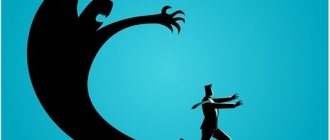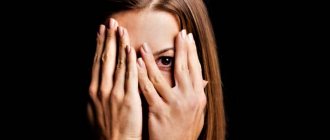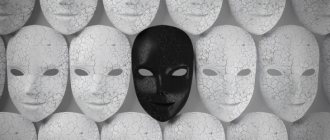What is fear?
Fear is an internal sensation that reflects a defensive reaction when experiencing real or imaginary danger.
In psychology, it belongs to the group of so-called negative or negative emotions - emotions that are based on unpleasant experiences or external influences. One type of fear is a phobia. This is an irrational, poorly controlled fear of an object, living creature or being in certain external circumstances. At the same time, a person tries with all his might to avoid contact with the source of his fear, even if it does not pose any objective threat.
Causes of fear
Fear is a natural response to a feeling of danger; it helps to avoid getting into situations that threaten health and life.
Depending on the type of fear, these may be external circumstances or internal experiences. Most often, this emotion is caused precisely by the features of the environment - closed space, height, darkness. Less often, fear is caused by a person’s feelings about social interaction with parents, loved ones or business partners.
The limbic system of the central nervous system, mainly the left amygdala, is responsible for the development of fear. The process is implemented through two neural pathways: short and long. The first is responsible for a quick reaction to potential danger, the second controls the adequacy of the response to the trigger and supports or blocks the shortcut. When the long path is disrupted, phobias arise. A number of hormones are also involved in the formation of feelings of fear, including cortisol, the “stress hormone.”
The most common types of fears and phobias are:
- Thanatophobia is the fear of one's own death.
- Stage fright is the fear of speaking in front of a large audience.
- Cynophobia is the fear of dogs.
- Acrophobia - fear of heights.
- Nyctophobia is the fear of the dark.
- Claustrophobia is the fear of enclosed spaces.
- Agoraphobia is the fear of being in places that cannot be quickly or easily left.
- Arachnophobia is the fear of spiders.
- Aviation phobia is the fear of air travel.
- Astralophobia - fear of thunderstorms.
Phobia: symptoms, main forms of the disease
The clinical manifestations of the disease primarily depend on its type.
There are several types of phobias:
- Simple. The patient develops an uncontrollable and clearly inadequate fear at the sight of a certain object, animal (insect), or before any situation (flying, going up to a height, changing weather, etc.). Due to a strong feeling of anxiety, a person diligently avoids such “irritants.” Some live in almost constant stress, often limiting themselves (for example, in travel, tourism, entertainment), without turning to a specialist.
- Social phobias. A person is afraid of situations when other people are watching him because of fear of discussions behind his back, criticism, ridicule. He tries to avoid public places (restaurants, cinemas, entertainment venues), avoids various meetings, conferences, lectures. This has an extremely negative impact on the patient’s quality of life, since fear often pushes them to use alcohol and drugs.
- Agoraphobia. A patient suffering from this form of disorder experiences extreme anxiety when he finds himself outside the home, among crowds, in places that he cannot quickly and independently leave. Agoraphobia is much more often accompanied by anxiety and depressive disorders, and depersonalization.
- Hypochondriacal phobias are fear of an existing concomitant pathology or fear of possible diseases. As a rule, they are afraid of oncology, infections (tuberculosis, tick-borne encephalitis, viral diseases, etc.). The patient constantly undergoes tests, undergoes examinations, turns to various specialists, but even a negative result relieves him of fear only for a short time. The patient listens to himself so much that the possibility of psychosomatic hypertension and autonomic dysfunction cannot be ruled out. And a banal slight deterioration in well-being, which many simply do not notice, can cause a panic attack.
Typical signs
The most common manifestation of a severe illness is a panic attack, for which the following symptoms are typical:
- heartbeat;
- tightness, feeling of heaviness in the chest;
- feeling of suffocation and lack of air;
- sweating;
- dizziness;
- a distinct fear of death or impending serious illness (heart attack or stroke, insanity, loss of consciousness, etc.);
- numbness in the body;
- convulsions (not common).
Clinical manifestations increase quickly; in general, an attack usually lasts about 30 minutes, less often - several hours.
According to the mechanism of manifestation, panic attacks are divided into:
- spontaneous, developing unpredictably;
- attributive, arising under the influence of certain circumstances or situations.
Without appropriate treatment, episodes of panic attacks and fear can develop into a chronic disorder. At the same time, in the intervals between attacks, an anxious and restless mood remains - the patient all the time subconsciously expects and experiences fear of certain objects.
Does your relative have a mental disorder?
Refuses hospitalization? Are you afraid that he will harm himself and others? Call or request a free consultation.
URGENT CONSULTATION
The doctor will arrive within 1 hour . We'll take you to the hospital ourselves. Emergency hospitalization - around the clock!
Types of fear
In modern psychological practice, the classification of fears according to Shcherbatykh Yu.V. is used, which includes:
- Natural or natural fears, which are a reaction to natural phenomena: lightning and thunder, earthquakes, animal aggression, etc.
- Social fears, represented by fear of responsibility, speaking in public, taking an exam, or having an important conversation.
- Internal or existential fears that are created by the person himself, for example: fear of one’s own thoughts and actions.
Children's fears are highlighted separately, including the fear of being alone, fear of other people, doctors, fairy-tale images, etc.
Signs of fear
Fear affects both a person’s physical condition and his behavior and well-being. Its manifestations can vary depending on the degree of potential threat from minor anxiety to panic.
State and feeling of fear
Fear is accompanied by the production of a number of hormones - adrenaline, norepinephrine and cortisol. They allow you to prepare for a response to a threat by changing the functioning of the heart, lungs and systemic metabolism.
The release of hormones puts the body in a state of heightened alert: blood supply to the muscles increases, blood glucose levels rise, and the brain concentrates only on potential danger. All this is accompanied by a number of somatic manifestations:
- Increased heart rate and breathing.
- Increased sweating.
- Dry mouth.
- Pupil dilation.
- Tunnel vision: a condition in which a person perceives visual information only about what they see directly in front of them. Peripheral vision is “turned off”.
- Inability to switch attention and thoughts to anything other than the source of fear.
- Dizziness and loss of appetite.
- General tension and increased muscle tone.
- Increased reaction speed and decreased pain sensitivity.
The mental reaction to fear varies from person to person and depends on the strength of the emotion. Often people feel only physical changes and anxiety, trying to avoid danger through their actions. With a sharp, sudden impact, a state of numbness and the inability to do anything is possible.
A short-term feeling of fear is harmless. However, with a long stay in this state, negative consequences are formed, such as:
- Sleep disturbance, insomnia.
- Decreased libido.
- Excessive irritability, aggressiveness.
- Frequent headaches.
- Decreased performance and loss of planning skills.
Why do people strive to experience fear?
The emotional response to fear is very individual and is often experienced differently by people.
Fear can also cause positive reactions in the human central nervous system. In some situations, the feeling of fear is regarded as entertainment, for example, while watching horror films. There are also people who provoke a feeling of fear in themselves - the so-called adrenaline junkies. Most often, these are people who are interested in extreme sports and other activities associated with risks to health and life.
Panic fear
Sometimes fear goes beyond the boundaries of a physiological reaction and becomes excessively strong, and a person goes into a state of panic, losing control over himself and the situation. If the reason for the appearance of such strong fear cannot be established, we are talking about a panic attack.
A panic attack is accompanied by extremely unpleasant sensations. Photo by Alex Green: Pexels
Panic attacks are often preceded by physical and emotional overload, and less often by sudden changes in hormonal levels. They are most often associated with the following factors:
- Chronic stress.
- Severe emotional shock.
- Long periods of sleep deprivation.
- Excessive physical activity.
- Severe somatic diseases, for example cancer.
- Pregnancy.
Panic attacks can also be a symptom of mental disorders, including: depression, psychopathy, hypochondria, schizophrenia, obsessive-compulsive disorder.
With panic fear, unlike its other types, symptoms may occur that resemble somatic diseases. Quite often this emotion is accompanied by:
- Feeling of chest pain.
- Shortness of breath, difficulty breathing.
- Feeling of numbness in the limbs.
- Fuzzy, clouded consciousness.
- Loss of consciousness.
Panic attacks last from several minutes to 1-2 hours, on average - about 30 minutes. They are also characterized by frequency, which can vary from 1-2 attacks per month to several per day.
Fear of pain
Algophobia or fear of physical pain is one of the common fears, which is often associated with previously experienced severe pain. In everyday life, it manifests itself when visiting medical institutions and dental offices.
Algophobia is common in children. Photo: FanMU/Depositphotos
Normally, a person tries to avoid harm to his health, which is often accompanied by pain. With algophobia, even the potential opportunity to feel pain causes strong fear with all its manifestations. An example is the fear of donating blood for laboratory tests due to the pain that is accompanied by puncture of the skin with a scarifier or syringe needle.
Fear of Rejection
Another fairly common fear is the fear of being rejected by society or a specific person. As a rule, it is formed against the background of a previous experience of a painful break with a person or rejection, for example, in a family. There is also a hypothesis that it is associated with autism spectrum disorders (autism, Asperger's syndrome) and attention deficit hyperactivity disorder (ADHD).
Negative experiences in the past can cause fear of being rejected by people. Photo by RODNAE Productions: Pexels
The fear of rejection is especially sensitive to interactions with other people:
- Constantly expecting the relationship to deteriorate and preparing for it.
- A persistent feeling of disrespect, ridicule and criticism addressed to you.
- An overly strong reaction to breaking up a relationship with someone. In this case, the response can be either severe aggression or depression.
Fear of getting coronavirus
The fear of infection with COVID-19 has become relevant today.
There is an opinion that it is based on the so-called “behavioral immune system,” which is behavioral characteristics aimed at minimizing the risk of getting a dangerous disease. The behavioral immune system evolved during a time when humans did not yet have such effective drugs to fight infections. This fear is fueled by constant news in the media about the number of new cases and deaths from this disease, the general mood in society and the understanding that effective drugs against the SARS-CoV-2 coronavirus have not yet been found.
Can phobias be treated with psychoanalysis?
What is a phobia? How do phobias differ from ordinary strong fears, so that they cannot be overcome by willpower?
A phobia is precisely the most common fear, it is simply NOT RATIONALLY JUSTIFIED. We often encounter the experience of fear - a child is sick; a loved one does not make contact; a car rushed nearby, almost hitting me; a dog attacked with barking; you didn’t find yourself in your usual place or you lost your passport or a large amount of money; the plane fell into an air pocket, etc. - all these fears are natural, understandable, explainable to the mind. Phobias are irrational - what's wrong with riding in an elevator or undergoing a painless MRI procedure? However, with claustrophobia this is completely impossible. What's wrong with walking through the supermarket; for the masses of people, this is generally the best pastime? However, with agoraphobia this is not possible. What's wrong with reading a prepared report in front of an audience or attending a seminar and meeting new people? However, with social phobia this is completely impossible. It is COMPLETELY IMPOSSIBLE! This is the distinctive feature of a phobia - the fear is too strong to be overcome by an effort of will, moreover, it becomes habitual, obsessive, haunting, and over time it increasingly manifests itself not only in a real situation, but also with one idea or memories of her, then the help of a specialist is required, namely a psychotherapist.
Is there any classification of numerous phobias?
There are countless phobias, there are even concepts of phobophobia - fear of facing the experience of fear, and panphobia - fear of everything in general. It is pointless to classify such a multitude of phobias; it is even very difficult to list them all, since the subject of fear can be any object or phenomenon in the world: from mysophobia - fear of microbial, infectious pollution to brontophobia - fear of thunderstorms. For some, everything that is connected or at least associated with nausea and vomiting is completely intolerable, so that a mother, for example, cannot breastfeed her own child for fear of his belching - this is vomitophobia. For some, crossing a bridge is completely irresistible, and panic seizes a person, even when he simply imagines that someone close to him is moving across the bridge - this is gephyrophobia. Aerophobia – fear of air travel; Aichmophobia – fear of sharp objects; acrophobia – fear of heights; aquaphobia – fear of water; hemophobia – fear of blood; cynophobia – fear of dogs; thanatophobia – fear of death; phagophobia – fear of choking on food; pharmacophobia – fear of taking medications; Iatrophobia is the fear of doctors... This is no more than 1% of phobias that only have an official name, because you can be afraid of anything.
It makes sense to highlight the most common and maladaptive phobias, which significantly limit activity and reduce the quality of life of a modern person. This is social phobia - fear of establishing new contacts and evaluation of oneself by others; agoraphobia – fear of being without support and accompaniment in a crowded, unfamiliar environment; numerous nosophobias (cardiophobia, speedophobia, oncophobia, etc.) - fear of various diseases, and in 2021 - especially of coronavirus infection; claustrophobia - fear, intolerance of closed, enclosed spaces and, in general, any hints of restriction of freedom of action; lissophobia - fear of mental disorder and, accordingly, loss of control over one’s behavior - impulsive harm to oneself or others, carrying out immoral acts against one’s will.
Some phobias have long overcome the scope of the psychiatric lexicon and mean hostility and aggression rather than fear, for example, xenophobia - rejection of everything unusual, different from oneself, or homophobia - rejection, aggression towards people of non-traditional sexual orientation.
What are agoraphobes really afraid of?
Agoraphobia is actually a set of phobias, the general meaning of which is the fear of being left without the support of loved ones, in a difficult situation, in an unusual environment, in front of everyone. A person may experience a state of severe anxiety when, for example, he has to find himself in a crowd, with a large gathering of people, moving away from home, going to an unfamiliar place, or simply riding on public transport.
Agoraphobe is afraid not so much of open spaces - noisy city streets, squares (although this is the literal meaning of the term), supermarkets, public transport, but of finding himself in unfamiliar conditions without the accompaniment of a loved one or relative. Psychologically, agoraphobia often hides the fear of being in an unpleasant situation in front of everyone - for example, fainting (and for women it means “ugly to fall”) or looking unnatural to others, involuntarily committing some morally condemned action. For an agoraphobe, the situation is unbearable when he is “in full view” among unfamiliar faces. He is quite comfortable within the confines of his house or apartment, but the fear of going beyond the threshold can be so insurmountable that even a psychotherapist is persistently invited to the house.
An alarming situation causes a whole series of physiological reactions in an agoraphobe, especially when trying to overcome this state by force of will, then a panic attack occurs - the most severe anxiety-vegetative reaction: acute fear, internal trembling, palpitations, weakness, dizziness, nausea, lightheadedness, suffocation, sweating , the need to empty the bladder and bowels. (More about panic attacks)
Do psychologists somehow explain the origin of phobias?
Psychoanalysis carried out for agoraphobia often shows that a person limits himself in the choice of methods of behavior and self-expression, does not allow creative self-disclosure, presenting himself to others as he is, outside of social roles and masks. Therefore, the content of an agoraphobe’s experiences is usually the fear that something unacceptable may happen to him, from his point of view, “in front of other people,” that he may lose control over his behavior and do something unacceptable, unacceptable. Accordingly, agoraphobia is often mixed with lissophobia (fear of madness, fear of going crazy), that is, the fear of losing rational, volitional control over one’s actions, and the subconscious fear of “falling low” in the eyes of others, causing their condemnation results, from the point of view of psychoanalysis , in fear of fainting, losing consciousness in front of everyone, thereby revealing their hidden moral weakness, helplessness and vulnerability.
However, one should always remember that psychoanalytic interpretations of phobias, symbolic interpretations of symptoms are not the ultimate truth, in fact, phobias are just habitual ways of manifesting neurotic anxiety, and in order to get rid of this kind of “bad habit” it is not at all necessary to plunge into the “wilds of the unconscious” .
Doesn't something similar happen to people who avoid communication in every possible way - social phobes?
Social phobia and agoraphobia are similar only at first glance. A sociophobe feels completely calm in a crowd of people who don’t care about him, but experiences fear and total uncertainty in situations related to direct communication, the need to interact, especially with strangers and in small groups, where you can easily find yourself in the center of the evaluator attention. Social phobia is, first of all, the fear of a negative assessment of one’s abilities with a subconscious desire to be ideal, to look better, more perfect than others, to surpass them in literally all respects. Psychologists see in this typical perfectionism, that is, a constantly high bar for one’s own achievements or even hidden narcissism (narcissism), which comes into conflict with total self-doubt, fragile self-esteem, and an “inferiority complex.”
In order not to experience fear of public speaking, it would be enough for another social phobe to simply accept the fact that his performance may turn out to be mediocre, no better than others, and the world will not turn upside down because of this, but this mediocrity is unacceptable for him in the first place.
What is claustrophobia?
This phobia, which is opposite in content to agoraphobia, means fear of closed spaces. A person who suffers from claustrophobia experiences discomfort or panic when being in a confined, confined, enclosed space or room. Traditional psychoanalytic explanations for such fears are quite well known: with claustrophobia, a person restrains his aggressive tendencies, fights his own unconscious protest, or tries to overcome someone’s power control and expand the boundaries of personal freedom. In his neurosis, he seems to be breaking free from a chain, tearing down walls, struggling in a web, trying to escape imprisonment. Moreover, it is precisely “as if” - whether this is actually true is impossible to objectively prove; some of the patients will certainly agree with this, while others will categorically deny it. The fact is that with claustrophobia, as with any other phobia, in the event of a forced, violent encounter with an unacceptable situation for oneself, for example, when locking an apartment from the outside, getting stuck in an elevator, a traffic jam on a large highway, or just the thought of that it is completely impossible to get out of the plane until it reaches its destination, a severe panic attack develops.
Is it worth fighting a phobia?
It is literally impossible to “fight” any neurotic symptom, incl. phobia, since the exhausting struggle with internal fear is the very essence of neurosis, and by simply fighting it, we only strengthen and aggravate the neurosis. You can get rid of fear in any way you like - by ignoring it, denying it, not attaching importance, switching attention, abstract observation of your fear, developing the ability to laugh at it, and even - purposefully immersing yourself in fear, in its very core, taking it to the very extreme, to the very peak, after which the experience of fear inevitably declines until it disappears completely. But not the way to fight! Struggle means grasping fear with your consciousness, not allowing it to simply pass by. It is precisely in such a struggle with a phobia that a neurotic constantly finds himself. Therefore, he must do whatever he wants, just not fight fear, not try to enter into direct confrontation with it, not reflect on the topics of his anxiety - all this actualizes fear, gives it value and significance, while the task is completely different - devalue fear, deprive it of significance, as if to “expose” it, deprive it of its reality and “materiality”. You can completely immerse yourself in fear in order to discover its illusory nature, emptiness, meaninglessness, ephemerality, but DO NOT RESIST it.
An example would be a situation where a child, who is always afraid of the dark, grows up and begins to understand that this cannot continue this way, that the fear of the dark is not based on anything, that there is nothing truly scary in the darkness itself, begins to be ashamed of his fear, feels a coward, and finally, one day, when his parents are not at home, he deliberately turns off the lights in the entire apartment and goes into the darkest room, promising himself not to leave there until all the fear in him is “exhausted” and ceases to exist altogether. And after that, he will truly never be afraid of the dark again. You can and should GROW out of fear!
Just don’t take such “experiments” as a direct guide to action, since with severe anxiety neurosis, the method of “plunging into fear” can also lead to a panic attack, followed by an even greater feeling of one’s own powerlessness. All such practices should be carried out with the participation of the attending psychotherapist, also because severe phobias simply cannot be overcome without medication support or preliminary treatment of situations of phobic avoidance in a doctor’s office using special techniques of cognitive-behavioral or hypno-suggestive therapy.
I am only stating the principle - you cannot fight fear. Fear must be experienced, rethought, it must be stepped over as if it were something imperceptible, insignificant, only then will it be overcome.
The essence of neurotic fear is that it itself instills fear - the fear of repetition of fear, the fear of encountering fear again and again. And as long as this neurotic fear of fear, of the anxious state itself, exists, it will not go away. Neurotic fear, like any other symptom of neurosis, is a ghost, a phantom. As in a fairy tale, in order for a frightening ghost to disappear, you need to clearly realize that it is ONLY a ghost, causing ONLY fear and... turn your back on it.
Let me emphasize that we are now talking about neurotic, i.e. rationally unfounded fears. All of the above does not mean at all that to get rid of the fear of the dark you need to walk through dark courtyards at night, and to get rid of the fear of heights you need to climb onto the parapet of a skyscraper. There is a significant difference between justified anxiety, which serves the purposes of the self-preservation instinct, and neurotic anxiety, which paralyzes life activity and limits our personal capabilities. Finally, a person always has his own choice of what he wants to be afraid of and what he does not want. When a person does not want to, does not see any sense, but, nevertheless, is forced to constantly fight and resist unreasonable fear, then, and only then, he is in a state of phobic neurosis. We can say that the essence of neurosis is not in fear itself, but in “getting stuck” on the problem of overcoming it, in the obsessive, forced need to constantly fight it.
Is it not possible to overcome, by force of will, any elementary fear, for example, ordinary zoophobia - panic in front of all living creatures - dogs, spiders, snakes, mice...?
As I already said - to overcome in the sense of “overcome” - no. And the fact that the fear is insignificant does not mean anything - all neurotic fears at first glance are insignificant, insignificant and unfounded, but this is precisely their whole problem. Fear acquires an obsessive character, fills the consciousness, and attempts to “overcome” or “overcome” it only intensify, as its significance in consciousness grows. However, you are right, sometimes you can use rational actions to eliminate the reason for the occurrence of a phobia: for example, using modern sanitary, epidemiological and technical means to prevent mice and insects from appearing in the house; carry pepper spray or a long umbrella against dog attacks; If you have claustrophobia, you can avoid using elevators and carry out an MRI scan on an open tomograph or by first taking a tranquilizer that “turns off” the panic reaction.
You just need to understand that the emergence of even a minor phobia, which seems to be possible to “bypass”, is still the “first bell”, indicating that the level of anxiety is increased and the mechanism of neurosis has already been launched. And then it is unknown whether a person will live his whole life simply avoiding some places and situations that are of little significance to him, or whether in a year his fear will increase to clinical manifestations. Therefore, it is still better to get rid of unreasonable fears and excessive anxious reactions in a timely manner than to “keep them to yourself.”
How to treat phobias?
Reliable results are achieved by combining medication with cognitive-behavioral/behavioural psychotherapy. Often one thing is enough, for example, only drug treatment if the general, so-called. generalized anxiety is too high, then reducing it with medication can also lead to the spontaneous disappearance of the phobia. If general anxiety is not high, and you only need to eliminate the “habit” of reacting anxiously to a specific situation, then psychotherapy alone is enough, incl. carried out by a psychologist and without the participation of a doctor.
Another option, for those cases when fear manifests itself under specific, infrequent circumstances, and the rest of the time a person feels quite comfortable, may be a single dose of a tranquilizer, which will not allow the development of an anxious-vegetative reaction. For example, if claustrophobia makes it impossible to conduct an MRI examination, then you do not need to take an antidepressant for a year or intensively engage in psychotherapy - just take a tablet of phenazepam (alprazolam, diazepam, clonazepam) an hour before the procedure. The same applies to aerophobia, if your lifestyle does not involve frequent flights, and social phobia, when anxious reactions are associated only with public speaking, which does not occur systematically. Tranquilizers are very comfortable drugs, ideal for eliminating situational anxiety; you just need to know that they should not be used for a long time and uncontrolled to avoid the formation of addiction.
If anxiety spreads beyond specific situations or if these situations occur regularly with high frequency, so that phobic experiences “grow too much”, taking on the character of a pronounced panic disorder, then it must be treated by a competent psychotherapist (not a neurologist!) with medication using new generation antidepressants, the so-called. SSRI group – selective serotonin reuptake inhibitors. In this case, the basis for long-term use should NOT be drugs from the groups of antipsychotics or tranquilizers. After eliminating all symptoms of autonomic dysfunction or in parallel with drug treatment, psychotherapy can be used.
Is it possible to identify the most preferable type of psychotherapy?
More effective and even proven effective in Western research in such cases is cognitive-behavioral psychotherapy, which allows you to “retrain” thinking to function in a fearless mode, without going into the essence of deep-seated personal conflicts. However, hypno-suggestive psychotherapy and full-fledged training within the framework of Gestalt psychotherapy, psychodrama or NLP can also give good results. Phobic neurosis is one of the most typical types of neurosis; accordingly, almost all classical methods of psychotherapy for neuroses are suitable for it.
Can phobias be treated with psychoanalysis?
If a patient is interested in the question of the origin of his phobias, then in accordance with the universal principle - “we all come from childhood”, this can be clarified during classical psychoanalysis or, as they also say, psychodynamic psychotherapy, but you need to be prepared for the fact that this is not always possible the revealed understanding of what is happening in the soul (so-called insight, catharsis) will immediately relieve the clinical symptoms of fear and anxiety. Psychoanalysis now is a long and expensive process of self-knowledge, self-research, and personal improvement rather than treatment.
Often, the persistent desire to discover and reveal or, as psychotherapists say, “react” to some forgotten childhood source of fear leads to an even greater surge of anxiety, so psychoanalysis in such cases should only be done with a conscious desire to know and understand oneself better, and not because just to “get better.” It’s just that getting cured in modern conditions can be easier, more effective and cheaper with the help of medications, of course, if they are used correctly.
Contrary to popular belief, multiple childhood fears are not the cause or source of an adult’s phobias, but a confirmation and manifestation of the fact that an increased level of anxiety, fearfulness and a tendency to panic reactions are inherent in a given person initially (including those noted in his parents), discovered themselves already in early childhood and became entrenched in consciousness due to the same high anxiety, the reduction of which is the main goal of both drug and psychotherapeutic treatment.
Interviewed by Alexander Hertz, “Healing Letters”
When to see a doctor?
Fear is not always useful, and in some cases it is recommended to seek help from a specialist. Reasons for seeking medical help may include:
- Panic attacks, especially those that occur for no apparent reason.
- Inability to engage in work or household activities and other daily activities due to fear and phobias.
- Constantly being in a state of fear for no apparent reason.
- Severe deterioration in physical condition due to fear.
- The appearance of fear against the background of other somatic (for example, bronchial asthma) or mental (schizophrenia) diseases.
- Sleep disorders.
If you have phobias, fears of specific things or circumstances, you should seek help from a psychologist or psychotherapist. It is also recommended to consult a specialist in this profile if you have groundless but controllable fears.
Before visiting a doctor, certain preparation and analysis of your condition is recommended. They will simplify the process of diagnosis and choice of treatment tactics. It is useful to prepare the following data in advance:
- All the symptoms that accompany the feeling of fear, even if they seem unrelated to the emotions experienced.
- Triggers are things, people, factors or external circumstances that provoke feelings of fear and anxiety.
- Reactions and methods of counteracting fears and phobias, including the results of their use.
- Previously experienced severe emotional shocks or stressful periods.
- A list of all medications, nutritional supplements and vitamins that are taken, as well as their doses.
How to deal with phobias?
Starting to fight your fear is often hindered by a reluctance to acknowledge the fact of its existence. Society believes that being afraid of something is stupid and shameful. This makes it more difficult not to deny the presence of a phobia. As a result, fear is driven somewhere far into our subconscious and carefully ignored.
The following ways can help get rid of this sticky, unpleasant feeling:
- Get over yourself. You need to look fear “in the eyes.” Try to survive the situation that seems monstrous and traumatic. Usually people who have managed to change themselves notice that their own idea of how everything will happen turned out to be much worse and more terrible than reality.
- Find the root cause. Try to remember or understand why you have such a fear or phobia. Once you realize this, it will be much easier to understand how to eliminate your fear.
- Visualization . Imagine how successfully you will overcome a difficulty you have, for example, the fear of speaking in public. Think clearly about how you will emerge victorious from the current situation. Having experienced a positive (albeit fictitious) experience, it will be much easier to turn everything into reality.
Treatment of fears
Treatment and combating pathological forms of fear may include both psychological techniques and drug support. The goal of the therapy is to reduce the frequency of unreasonable attacks of fear and their severity, as well as to prevent negative consequences for the body and control phobias.
Cognitive behavioral therapy
This is one of the options for conversational psychotherapy, which involves searching, analyzing and working through a person’s thoughts and beliefs that potentially cause fears and underlie phobias. This therapy is based on reinforcing the desired types and characteristics of behavior, which entails a change in emotions and thinking, leading to the development of fears.
Over the course of a series of sessions, the psychotherapist helps to respond in a structured manner to situations and factors that cause feelings of fear and to respond to them more effectively. The number of visits to the doctor can vary from 5 to 20 depending on the severity of symptoms, support from others and personal progress.
Group classes
An effective approach to treating fears is group therapy, in which people with similar problems communicate. It is believed that getting to know the stories of others, especially if they have successfully confronted their phobias and have already achieved certain results, helps to better deal with personal experiences. It also allows you to get new advice and learn about new treatment tactics and choose the most suitable option for yourself.
Group classes help to cope with fears. Photo: PsychotherapyNet / YouTube
Drug treatment
Psychotherapeutic approaches are considered the most effective. Drug treatment is used for severe symptoms of anxiety and fear that cannot be overcome by other means.
Depending on the person’s condition and associated factors, medications can be prescribed either as a short course at the beginning of therapy or on an ongoing basis. To combat the feeling of fear and its consequences, the following groups of medications are used:
- β-blockers. These are medications that block the effects of hormones on the body that are released during the experience of fear.
- Tranquilizers, mainly benzodiazepines. Directly suppresses anxiety and fear. At the same time, they can be addictive and are not recommended for use in cases of alcohol and drug addiction.
When phobias and fears appear against the background of psychiatric diseases, sleeping pills, antipsychotics and antidepressants can also be used. However, such funds should not be used by a person independently - they are prescribed only by a competent specialist after a comprehensive examination.
Devices for measuring the level and strength of fear.
In the process of the development of science, scientists received various devices with the help of which it became possible to carry out psychophysiological diagnostics of a person. At the beginning of the 19th century, the French doctor S. Feret and the Russian physiologist Tarkhanov independently discovered that when fear occurs in human skin, its electrical properties change. This is how the galvanic skin response (GSR) was discovered, which is the most informative component of a polygraph (lie detector). Thanks to GSR, you can measure the level of fear.
Today, the polygraph is one of the most accurate instruments that can be used to measure the body's reaction to a stimulus, which can be either dangerous or non-dangerous.
How to get rid of fear?
You can start confronting your fears and phobias on your own. For this purpose, a number of tips and recommendations have been developed. However, you should not expect quick results - it is a long journey that always starts small.
AWARE technology
One of the effective ways to get rid of fear is to study and accept it. For this purpose, a special AWARE (awareness) technique is used. This acronym stands for:
- Accept - recognition. Acceptance of your fear, a kind of recognition to yourself. Often, already at this stage, a person’s quality of life improves significantly.
- Watch - observation for the purpose of which you can keep a so-called “alarm diary”. It should record all thoughts and sensations that accompany the episode of fear, factors and situations that provoke or aggravate it.
- Act - action. Control of behavior, it should be as if everything is normal, even if fear is present. For example, you should continue to go to the place that causes unreasonable fear. This helps suppress an overly emotional response.
- Repeat - repetition. The previous points should be repeated on a regular basis, even if the first attempts seem unsuccessful.
- Expect - expectation. Confidence in your abilities and the fact that fear can be controlled gives you even more self-confidence and helps you master your phobias.
Proper nutrition
High blood glucose levels are associated with increased feelings of anxiety. Therefore, you should avoid large amounts of carbohydrate foods in your diet, giving preference to fresh fruits and vegetables.
It is also recommended to limit the consumption of strong tea and coffee, as they are rich in caffeine, which can increase the level of emotional arousal and anxiety.
Quitting alcohol and smoking
Despite the popular habit of drinking and smoking “for courage,” alcoholic drinks and tobacco products increase the level of arousal of the nervous system, thereby increasing anxiety and fear.
Sports activities
Sports and exercise force a person to concentrate, which allows him to take his mind off fears and worries. Also, being in good physical shape gives additional self-confidence, which helps in the fight against internal worries.
Relaxation
One of the simplest approaches to counteracting fear is relaxation techniques. Even a simple deep breath and exit helps you gather yourself and take control of the situation. You can also try to imagine yourself in a pleasant, relaxing place.
Listening to your favorite music helps many people. In the long term, massage, yoga, tai chi and meditation can be effective.
Every person is capable of overcoming fear.
Fear makes us anxious and apprehensive. We become more cautious, picky, suspicious, and this often interferes with enjoying life itself. You have to be constantly on your guard. The phobia becomes our internal burden, which we have to carry with us every day.
Perhaps we should try to get rid of it?
When you decide to fight your fear or phobia, remember!
- Every person has hidden forces within him to fight.
- The causes of fear lie within you, for example, some traumatic situation from childhood.
- Fear causes you to become addicted, and almost any addiction can be overcome.
Remember, you are not alone. If you want to live a calm life and get rid of the fear that interferes with your normal life. The time has come, you have already passed 50% of the way and you have very little left.











